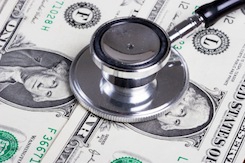More services are available to help you know the cost of a health-care procedure or visit before you make that appointment.
The good news: there are more advanced medical processes and treatments than ever to help us improve or recover from our ailments. The bad news: all of this is costing us more. New and more expensive medical technology and pills—and increased chronic conditions like diabetes and heart disease—are causing health-care costs to rise. And more employers are shifting their increased cost burden to their employees through high-deductible plans, higher co-pays and higher premiums.
There are ways to be a savvy health-care shopper, though, thanks to insurers, states and private companies who are helping make costs more transparent—which means you can now comparison shop for everything from an office visit to an X-ray.
Your health plan
The first place to start is with your health plan. Many of the larger insurance companies offer pricing information through their websites. Keep in mind that prices will likely reflect in-network negotiated doctor and facility rates.
Your employer
You can also check with your employer. Many are partnering with private companies that have developed detailed databases, such as Castlight or change:healthcare. After all, the less you pay in health care the less your employer has to pay.
Your state
Some states have developed websites that list health-care costs, and other states are expected to follow suit. Check the All-Payer Claims Database Council and click the link for your state to see if such a database exists.
Your computer
Several websites are available to consumers to do their own research free of charge. You can find health-care costs typical for certain geographical areas at FAIR Health™. With Healthcare Blue Book you can look up what the site deems “fair prices” for services in your area. OutofPocket is another free service; type in the medical service you’re researching, say MRI, and you’ll be provided with a number of links to help you find the price.
None of these services are perfect and many gaps in pricing still exist. However, with this information you can be better informed and utilize more cost-friendly health-care providers and facilities. Don’t want to switch to a new doctor? Try using the data you’ve collected to negotiate a better rate with your current doctor. (If you’re a member of an insurance plan that has already negotiated rates with the health provider or facility, you likely won’t be able to negotiate any lower.)
Find more ways to save on your health-care costs here.
Related Articles
- Free Medicare Services
- Do You Need Medicare Part D Insurance?
- Prescription Insurance
- Medicare Supplement Changes for 2010
- Why You Need A Personal Health Record
- Affordable health insurance: How to save on your health-care costs
- Purchasing Individual Health Insurance: What you need to know
- HMO Insurance
- Do You Need Long Term Care Insurance?
- Why You Need Long Term Disability Insurance
- Medicare Prescription Drug Coverage
- Medigap Supplemental Insurance Explained
- Supplemental Insurance - What Is It?
- Medical Marijuana - Should Marijuana Be a Medical Option?
- Prescription Drugs - Should They Be Advertised to Consumers?
 Print
Print Email
Email








